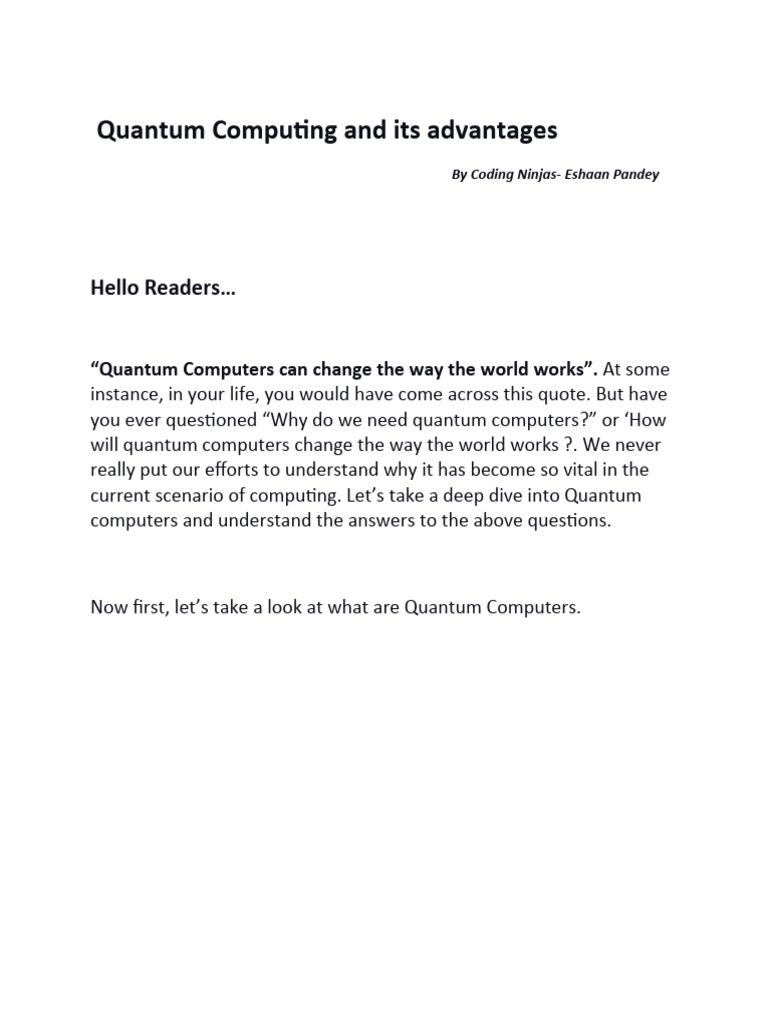As we stand at the precipice of a technological renaissance, one cannot help but ponder: what makes quantum computation so powerful? This inquiry invites innumerable reflections on computation’s very essence, suggesting an exploration that transcends classical paradigms. Let us embark on a journey through the labyrinthine corridors of quantum logic, examining the distinctive features that render quantum computation a formidable paradigm in the computational landscape.
To lay the foundation, it is essential to juxtapose classical and quantum computing. Classical computers operate on bits as their fundamental units of information—these bits exist in a binary state of either 0 or 1. This deterministic framework, while powerful in its own right, is constricted by the limitations of linear processing. In contrast, quantum computers utilize qubits, which can exist simultaneously in multiple states due to the properties of superposition. This feature alone amplifies the computational power exponentially, allowing quantum systems to execute many calculations at once.
What if we were to ponder further this notion of superposition? Imagine a chess player contemplating not just one move at a time but simultaneously calculating myriad potential futures. At its core, superposition vastly increases the computational capacity of quantum devices, making them adept at addressing complex problems previously deemed intractable. For instance, in fields encompassing cryptography, material science, and drug discovery, the multitudes of possibilities that quantum computation can explore present solutions at an unprecedented pace.
Another cornerstone of quantum computing is entanglement, a phenomenon that allows qubits to become interlinked in such a manner that the state of one qubit can instantaneously affect the state of another, irrespective of the distance separating them. This cryptic connection enables quantum computers to perform convoluted calculations with unparalleled efficiency. The ramifications of entanglement ripple across various domains, such as quantum teleportation and superdense coding, vividly illustrating how information can traverse distances in ways classical systems cannot fathom.
Moreover, let us consider the principle of interference, which helps to consolidate the computational power inherent in quantum algorithms. Quantum systems can leverage constructive and destructive interference to enhance the probability of correct outcomes while simultaneously diminishing the likelihood of erroneous results. Algorithms like Grover’s and Shor’s illustrate this advantage starkly. Grover’s algorithm can search unsorted databases with a speedup factor of √N, while Shor’s algorithm can factor large integers exponentially faster than the best-known classical algorithms. Herein lies a playful challenge: can conventional cryptographic protocols withstand the seismic shift precipitated by such advancements in quantum capabilities?
In the realm of optimization problems, quantum annealing offers another vantage point from which to appreciate the power of quantum computation. Classical methods often employ exhaustive search techniques that falter as the complexity of a problem grows. Quantum annealers, however, exploit quantum tunneling, enabling them to traverse the solution landscape more deftly, often yielding optimal or near-optimal solutions in markedly reduced timescales. This poses yet another intriguing question: as industries increasingly harness quantum annealing for logistical and operational efficiencies, what implications will this hold for existing industries steeped in classical methodologies?
The combined prowess of superposition, entanglement, interference, and quantum annealing thrusts quantum computation towards capabilities unreachable by traditional systems. This is exemplified in its application within machine learning—a paradigm that seeks to derive insight from complex datasets. Quantum algorithms can enhance pattern recognition and classification tasks, effectively handling vast amounts of information with a degree of sophistication previously unattainable. The tantalizing prospect looms: could quantum-augmented machine learning redefine our understanding of knowledge extraction from data?
However, traversing the path of quantum computation is not without its challenges. While the theoretical frameworks and foundational principles are robust, realizing practical quantum computing systems is fraught with difficulties. Qubits are notoriously sensitive to their environments, leading to decoherence and loss of information. Error correction mechanisms, albeit indispensable, introduce additional complexity and resource demands. Will the continual advancements in quantum error correction be sufficient to mitigate these formidable obstacles?
Simultaneously, the race to build scalable quantum processors persists, as researchers experiment with various physical implementations, such as superconducting qubits and trapped ions. Each approach presents unique advantages and drawbacks, a veritable smorgasbord of choices leading to variance in performance and scalability. As scientists grapple with the myriad factors influencing qubit fidelity and operational lifespan, the question of how swiftly practical quantum machines can emerge remains lingering and unresolved.
Despite these hurdles, the potential impacts of quantum computation are monumental. Industries ranging from pharmaceuticals to finance stand to gain remarkably from quantum advancements. In blockchain technology, for example, quantum computing could render existing encryption methods obsolete, prompting a reevaluation of cybersecurity measures worldwide. As we contemplate the intermingling of quantum and classical realms, a larger philosophical question arises: how will society adapt to a reality where quantum computing alters the very fabric of information technology?
In conclusion, the profound capabilities that quantum computation offers are intricately woven with challenges that compel inquiry and exploration. The interplay of superposition, entanglement, interference, and quantum annealing underscores a transformative potential, yet the practical realization of such technology remains fraught with obstacles. As we navigate this nebulous frontier, the question remains: are we prepared to embrace the quantum future, with its promises and perils?










